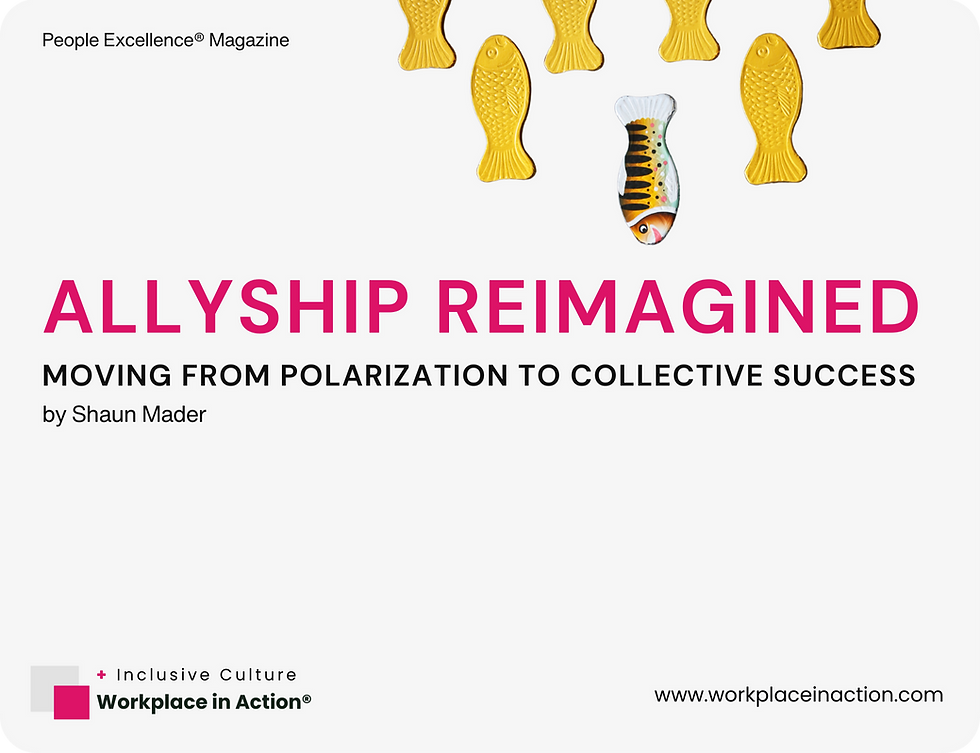Microaggressions in the Workplace & Building a Culture of Respect
- Dec 25, 2023
- 3 min read
Updated: Nov 9, 2024

In today's world, embracing diversity, equity, and inclusion (DEI) in the workplace is essential for businesses to succeed. A DEI-focused work environment promotes innovation, creativity, and a sense of belonging among employees. However, achieving this ideal can be challenging due to subtle behaviours known as microaggressions. This essay will explore the concept of microaggressions in the workplace, their impact on DEI, and strategies for creating an inclusive work culture.
Understanding Microaggressions in the Workplace are everyday verbal, nonverbal, and environmental slights or insults, whether intentional or unintentional, that communicate hostile, derogatory, or harmful messages. These actions often stem from unconscious biases and can significantly impact the work environment. In the office, microaggressions can manifest in various forms, such as making assumptions about someone's abilities based on their race or gender, using inappropriate jokes, or consistently mispronouncing a colleague's name.
Impact on DEI Microaggressions can erode the pillars of DEI in a workplace. They create an atmosphere of exclusion and discomfort, particularly for those from marginalised groups. This affects individual well-being and can lead to broader issues such as decreased productivity, higher employee turnover, and a tarnished company image.
Avoiding Microaggressions To foster a DEI-centric workplace, it is crucial to be aware of and actively avoid microaggressions.
This involves:
Education and Awareness: Conducting regular DEI training sessions to educate employees about microaggressions and their impact.
Encouraging Empathy: Promoting an empathetic work culture where employees are encouraged to understand and respect each other's backgrounds and experiences.
Fostering Open Communication: Creating open and respectful dialogue channels where employees can discuss DEI issues and share their experiences.
Encouraging Self-Reflection: Motivating employees to reflect on their biases and behaviours and understand how these might contribute to microaggressions.
Adressing various microaggressive behaviors:
Microaggression Behavior | Impact/Severity | Explanation |
Making assumptions based on race or ethnicity | High | Creates a hostile environment and perpetuates stereotypes, causing significant distress. |
Using inappropriate jokes or language | Moderate to High | Fosters an uncomfortable, disrespectful atmosphere, affecting morale and productivity. |
Overlooking ideas from certain groups | Moderate | Leads to undervaluing employees, impacting engagement and career progression. |
Consistently mispronouncing a colleague's name | Low to Moderate | Signifies disrespect and a lack of effort to acknowledge an individual's identity. |
Interrupting or talking over colleagues | Low to Moderate | Diminishes a person's sense of belonging and undervalues their contributions. |
Excluding certain employees from social events | Moderate | Causes feelings of isolation, affecting team cohesion and trust. |
Making dismissive gestures or facial expressions | Low to Moderate | Non-verbal cues can be demeaning and create an unwelcoming environment. |
Questioning the qualifications of a colleague based on their background | High | Undermines professional credibility, leading to a toxic work culture. |
Assigning roles or tasks based on stereotypes | High | Reinforces discriminatory beliefs and limits professional growth opportunities. |
Ignoring or minimizing experiences of discrimination | High | Invalidates personal experiences, leading to a lack of trust and safety in the workplace. |
Mimicking or mocking accents or cultural expressions | High | Shows disrespect for cultural diversity and can cause significant emotional distress. |
Avoiding interaction with certain groups | Moderate | Creates divisions and hinders collaborative and inclusive team dynamics. |
Using microaggressions under the guise of humor | Moderate to High | Trivializes serious issues, creating a dismissive and harmful work environment. |
Oversimplifying or generalizing complex cultural issues | Moderate | Demonstrates a lack of understanding and respect for diverse experiences. |
Failing to acknowledge religious or cultural observances | Low to Moderate | Can make individuals feel unrecognized and undervalued in their cultural identity |
A comprehensive overview of various microaggressive behaviors, their potential impact, and reasons for their inappropriateness in a workplace setting. It's a useful guide for understanding and addressing behaviors that undermine a DEI-focused environment.
Creating a DEI-based Workplace: Workplace in Action® To transform the principles of DEI into actionable steps, the concept of "Workplace in Action®" can be pivotal. This approach involves:
Inclusive Policy Making: Developing and implementing policies promoting DEI, such as fair recruitment practices, equal pay, and zero tolerance for discrimination.
Diverse Leadership: Ensuring diversity in leadership positions reflects a commitment to DEI and provides role models for all employees.
Regular DEI Assessments: Conduct periodic assessments to evaluate the effectiveness of DEI initiatives and make necessary adjustments.
Celebrating Diversity: Regularly recognising and celebrating employees' diverse backgrounds and cultures through events and acknowledgments.
Creating Safe Spaces: Establishing forums or committees where employees can discuss DEI issues and seek support.
A DEI-based workplace is not just about policies and training; it's about cultivating a culture where every employee feels valued and respected.
By recognising and mitigating microaggressions, promoting inclusive practices, and implementing the "Workplace in Action®" approach, organisations can build a genuinely inclusive environment.Such a workplace enhances employee well-being and drives innovation and success in today's global business landscape.
Contact us and learn more how we can support you.
_edited.png)




Comments